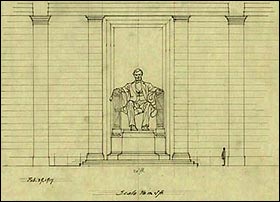|
 |
 |
One of Henry Bacon's original sketches shows
the placement of the Lincoln statue created by Daniel Chester French.
Credit: Library of Congress
|
 |
 |
The 1922 dedication of the Lincoln
Memorial.
Credit: Library of Congress, National Photo Company Collection.
|
 |
 |
Marian Anderson's 1939 concert
at the Lincoln Memorial.
Credit: Marian Anderson Collection of Photographs, Rare Book & Manuscript Library, University of Pennsylvania Library
|
|
|

|
|
THE MALL: 1901 - 1940
The Lincoln Memorial
The 1901 McMillan Plan for the Mall emphasized the role of the Civil
War in American history with its plan for the construction of a memorial
to Abraham Lincoln. Architect Henry Bacon designed the Lincoln Memorial
and Daniel Chester French created the sculpture of Lincoln inside the
memorial. Its builders intended the Lincoln Memorial as a dramatic object
lesson in patriotism and reconciliation between the North and the South.
It was planned for the western end of the Mall as not only the terminus
to the Mall but also the beginning point for a memorial bridge into Virginia
that physically and symbolically linked the North to the South. The keynote
speeches at the dedication focused mostly on reconciliation. President
Harding said, "The supreme chapter in history is not emancipation. Emancipation
was a means to the great end — maintained unity and nationality."
In his speech, the racial issues of the Civil War were basically ignored.
Once the Lincoln Memorial was dedicated in 1922, its meaning changed
as people began to use the site for Civil Rights gatherings. The first
major gathering at the Lincoln Memorial occurred on April 9th, Easter
Sunday, 1939 when internationally renowned opera singer Marian
Anderson sang on the steps of the memorial. The Daughters of the American
Revolution had refused her the use of their concert hall because she was
black. They said they were merely following local custom. Eleanor Roosevelt
resigned from the D.A.R. in protest. Walter White of the NAACP and other
black leaders asked Harold Ickes, Secretary of the Interior, if Anderson
could sing at the Lincoln Memorial. Ickes enthusiastically backed the
idea. 75,000 came to hear Marian Anderson sing in what became known as
the "Freedom Concert."
Next: The Mall: 1940-1980 »
« Previous: Early History: The 19th century and the 1901 McMillan Plan
|